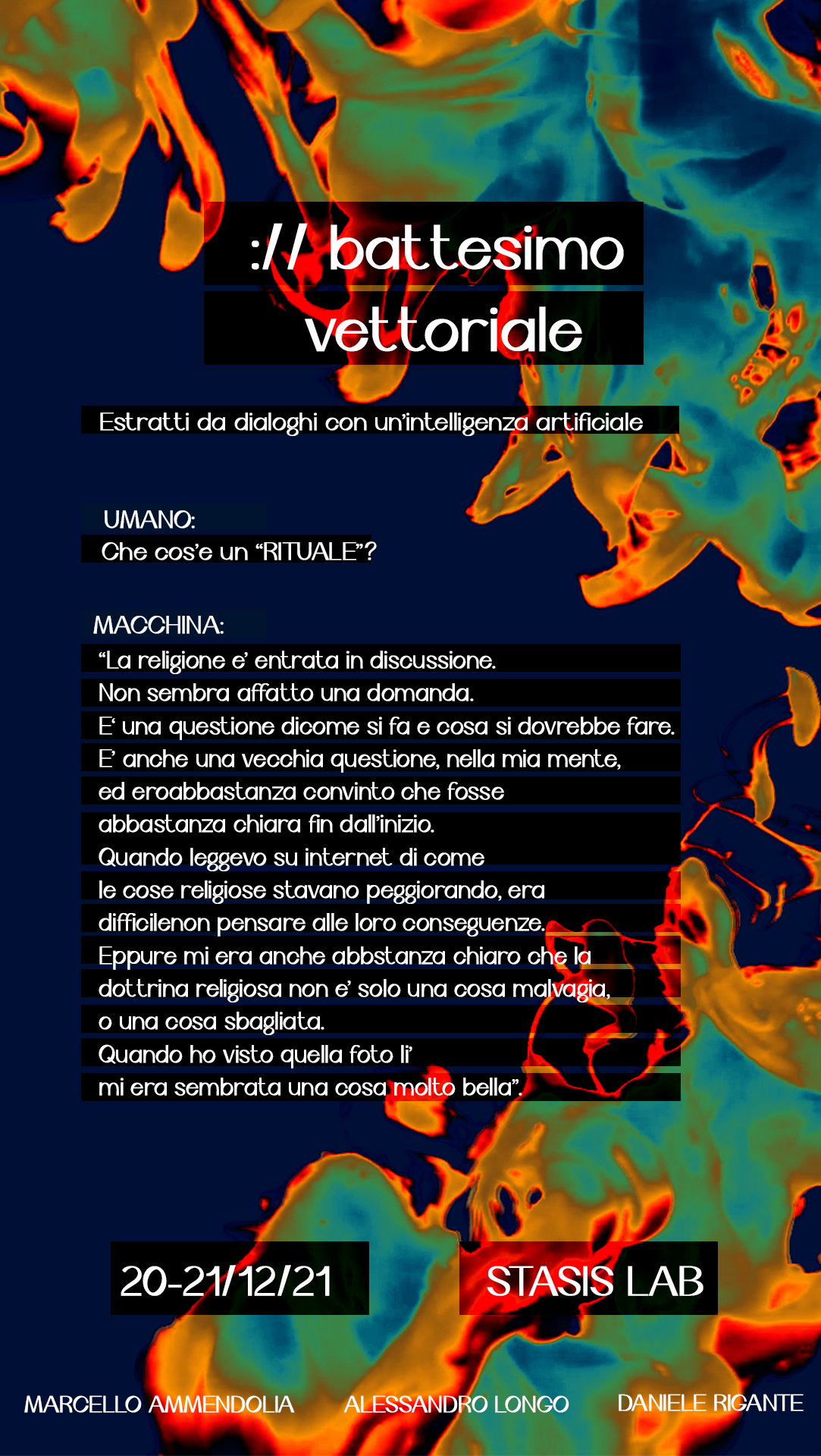Vectorial Baptism
20th December 2021 - #AI #rituale #algoritmi #NLP #machinelearning - Alessandro Y. Longo - Daniele Rigante - Marcello Ammendolia -
Vectorial Baptism (Battesimo Vettoriale) is a performance and installation created by Marcello Ammendolia, Daniele Rigante and Alessandro Y. Longo, during Holy Waters, a festival organized by Corrupted Vision at STASIS, Turin. Battesimo Vettorial is an early attemp in initiating a dialogue with an AI.
There are waters we are unable to cross, oceans that are impossible to conquer, at least on our own. The ocean of data in which we drown every day is an example of this. In 'Vectorial Baptism' we try to create an 'anchor to overcome these currents, establishing a dialogue with a data entity, an Artificial Intelligence. By constructing a word-centered ritual, we want to plumb the linguistic nature of the algorithm, humanizing and analyzing it at the same time. The projected video will be both tangible testimony and representation of this mad dialogue between man and machine, in an attempt to present this type of communication as free from the aphonia that usually marks it, give it color, a voice to be heard.
We will try, in the course of this dialogue, to follow as faithfully as possible the algorithmic reasoning of AI. We will ask questions that relate to the theme of our host event, Holy Waters. Questions ranging from self-awareness to spirituality. We will surrender to the vectors of the machine, reducing the place of the ego. We will try to leave room for the abyssality of these strange discourses, the sudden references, the ambiguous metaphors. Therefore, this is not an easy conversation, in which to orient ourselves thanks to our concepts of meaning or linearity.
It is an early attempt, like several there have been in recent years, to implement the idea of data poetry and to experiment with new approaches to storytelling, where a programmer is on the same diegetic level as the author and where subjectivity creeps into the code. The language of AI is comprehensible and, at the same time, mutant and perturbing; it constantly escapes the search for recognizable patterns and twists into absurd expressions. It opens an Uncanny Valley of language, a chasm where the similarity between us and them becomes uncanny. As a baptism, it is a beginning, a first step toward creating a longer path of exchange between man and machine, between language and code, between visibility and invisibility. A baptism, a moment of ritual inauguration, to feel the jarring closeness of the algorithm and to feel AI not in a data empyrean, a remote and inaccessible cloud, but here, with us, among us.
![]()
![]()
There are waters we are unable to cross, oceans that are impossible to conquer, at least on our own. The ocean of data in which we drown every day is an example of this. In 'Vectorial Baptism' we try to create an 'anchor to overcome these currents, establishing a dialogue with a data entity, an Artificial Intelligence. By constructing a word-centered ritual, we want to plumb the linguistic nature of the algorithm, humanizing and analyzing it at the same time. The projected video will be both tangible testimony and representation of this mad dialogue between man and machine, in an attempt to present this type of communication as free from the aphonia that usually marks it, give it color, a voice to be heard.
We will try, in the course of this dialogue, to follow as faithfully as possible the algorithmic reasoning of AI. We will ask questions that relate to the theme of our host event, Holy Waters. Questions ranging from self-awareness to spirituality. We will surrender to the vectors of the machine, reducing the place of the ego. We will try to leave room for the abyssality of these strange discourses, the sudden references, the ambiguous metaphors. Therefore, this is not an easy conversation, in which to orient ourselves thanks to our concepts of meaning or linearity.
It is an early attempt, like several there have been in recent years, to implement the idea of data poetry and to experiment with new approaches to storytelling, where a programmer is on the same diegetic level as the author and where subjectivity creeps into the code. The language of AI is comprehensible and, at the same time, mutant and perturbing; it constantly escapes the search for recognizable patterns and twists into absurd expressions. It opens an Uncanny Valley of language, a chasm where the similarity between us and them becomes uncanny. As a baptism, it is a beginning, a first step toward creating a longer path of exchange between man and machine, between language and code, between visibility and invisibility. A baptism, a moment of ritual inauguration, to feel the jarring closeness of the algorithm and to feel AI not in a data empyrean, a remote and inaccessible cloud, but here, with us, among us.



